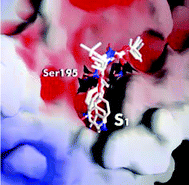On the rational design of substrate mimetics: the function of docking approaches for the prediction of protease specificities
Abstract
The behaviour of substrate mimetics in mediating the acceptance of nonspecific

* Corresponding authors
a
University of Leipzig, Faculty of Biosciences, Pharmacy and Psychology, Institute of Biochemistry, Brüderstr. 34, D-04103 Leipzig, Germany
E-mail:
robguent@uni-leipzig.de
Fax: +49 341 973 6998
Tel: +49 341 973 6737
b
Max-Planck Society, Research Unit for Enzymology of Protein Folding, Weinbergweg 22, D-06120 Halle/Saale, Germany
E-mail:
bordusa@enzyme-halle.mpg.de
Fax: +49 345 551 1972
Tel: +49 345 552 2806
The behaviour of substrate mimetics in mediating the acceptance of nonspecific

 Please wait while we load your content...
Something went wrong. Try again?
Please wait while we load your content...
Something went wrong. Try again?
R. Günther, C. Elsner, S. Schmidt, H. Hofmann and F. Bordusa, Org. Biomol. Chem., 2004, 2, 1442 DOI: 10.1039/B316641D
To request permission to reproduce material from this article, please go to the Copyright Clearance Center request page.
If you are an author contributing to an RSC publication, you do not need to request permission provided correct acknowledgement is given.
If you are the author of this article, you do not need to request permission to reproduce figures and diagrams provided correct acknowledgement is given. If you want to reproduce the whole article in a third-party publication (excluding your thesis/dissertation for which permission is not required) please go to the Copyright Clearance Center request page.
Read more about how to correctly acknowledge RSC content.
 Fetching data from CrossRef.
Fetching data from CrossRef.
This may take some time to load.
Loading related content
